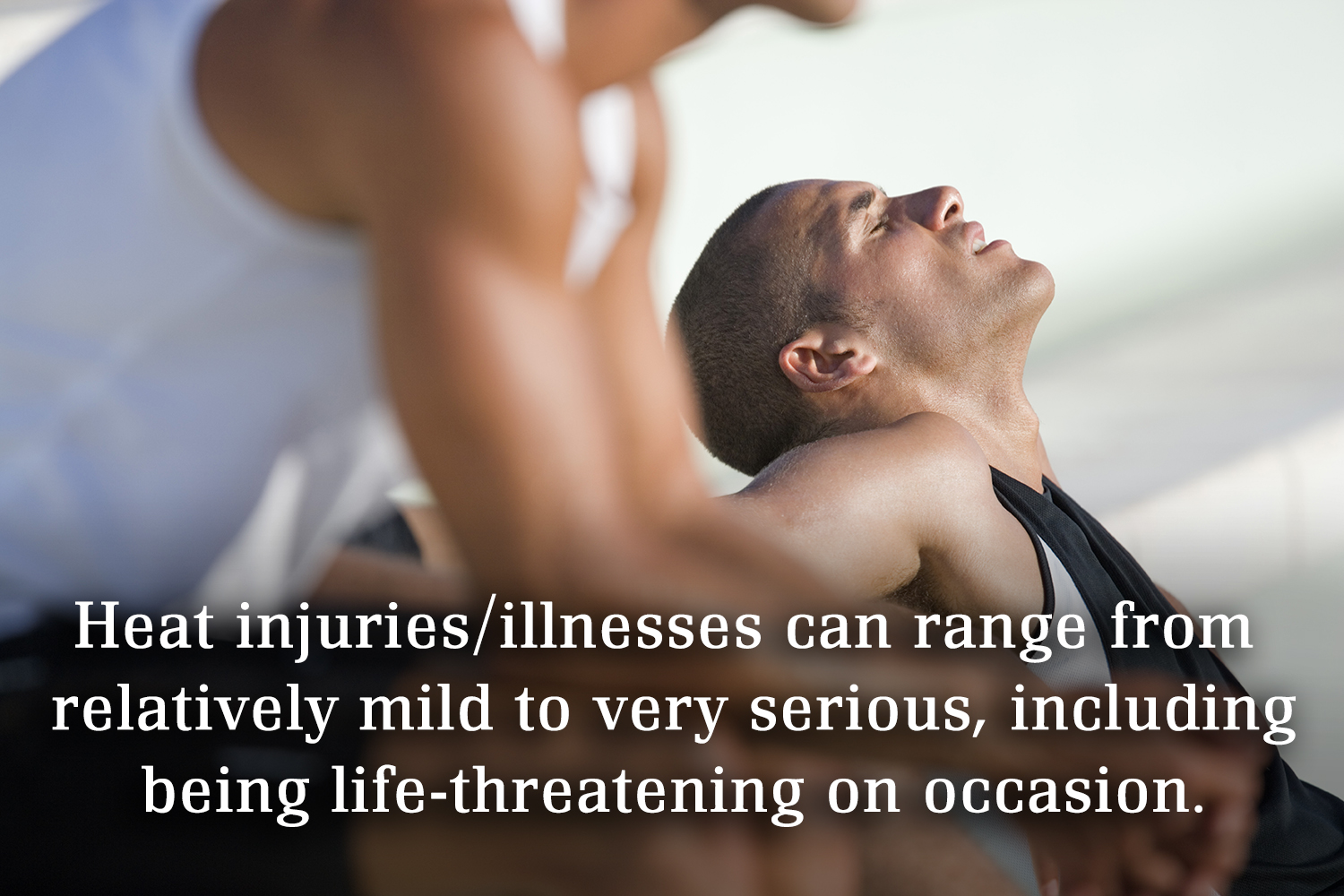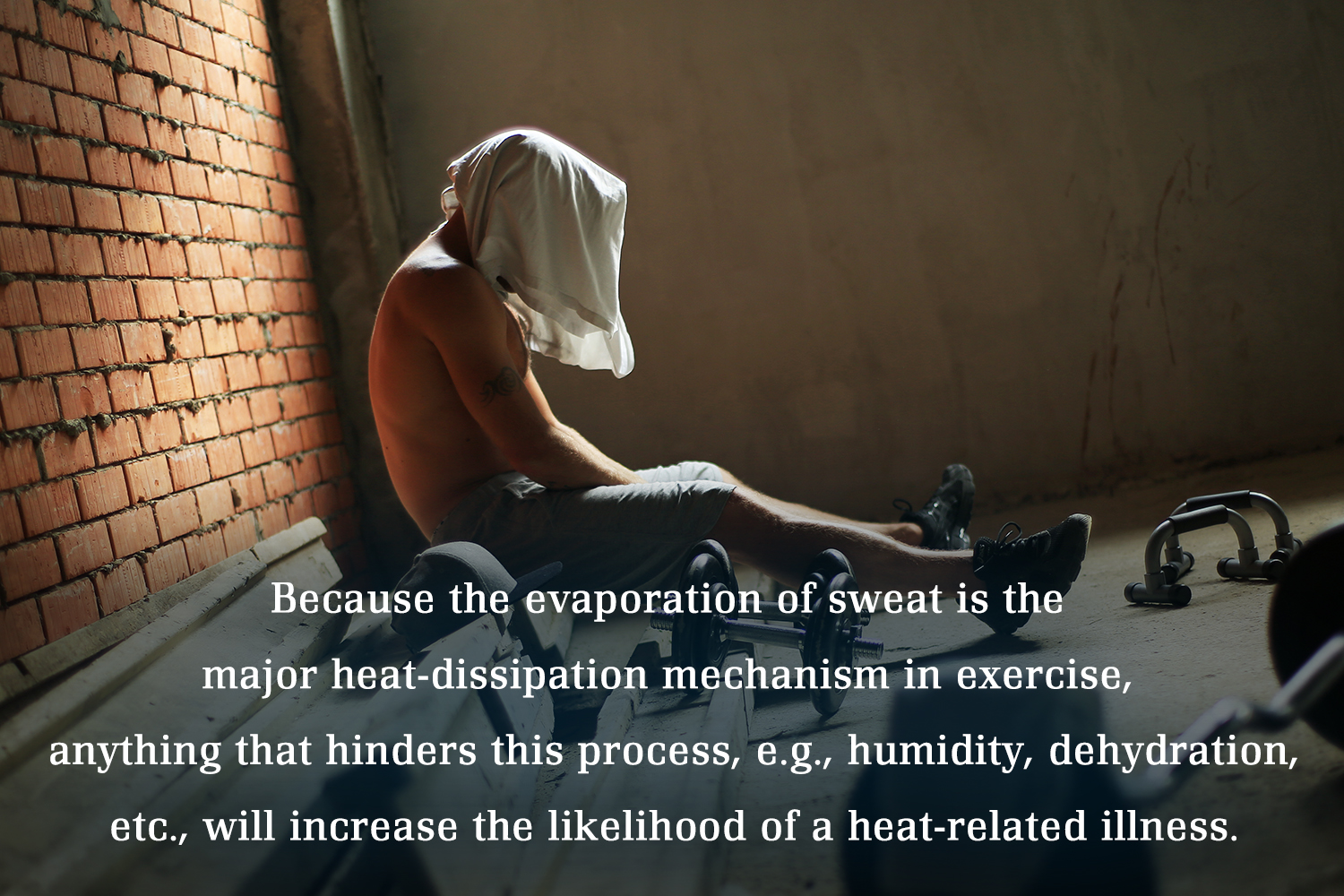Heat Injuries and Heat Illness
Posted by Dr. Craig K. Seto on Nov 18th 2019
During exercise or when the temperature is above 68 degrees Fahrenheit, most of the body’s heat loss occurs at the skin surface by the evaporation of sweat.
Evaporation is the most important way the body cools itself during exercise. During maximal exercise, muscles can produce 15 to 20 times more energy than at rest. The majority of this energy is converted to heat that quickly raises the core body temperature of the athlete.
With continuous exercise, the core temperature will rise one degree Celsius every five minutes, causing the body to initiate sweating and to increase blood flow to the skin. A 155-pound athlete can sweat 1 to 2 liters per hour during intense exercise with larger athletes sweating considerably more.
The evaporation of sweat is an excellent way to dissipate heat. Since each milliliter of evaporated sweat can consume about 0.6 kcal of heat, a well-conditioned athlete has the ability to dissipate well over 1,000 kcal of heat per hour.
Once the heat-dissipating mechanisms are brought into play, the body’s core temperature will reach a plateau, where it remains until the exercise demand is past. This temperature plateau represents the equilibrium between heat production and heat dissipation. In elite athletes, this temperature plateau may be as high as 104 F, during which exercise can take place without diminished performance.
If, however, any of the heat-dissipating mechanisms fail and overwhelming heat stress exists, core temperature will continue to rise until a heat injury is produced. Because the evaporation of sweat is the major heat-dissipating mechanism in exercise, anything that hinders this process, such as humidity, dehydration or inappropriate clothing, increases the likelihood of a heat-related illness.
The process by which an athlete’s body adapts to exercising in a warmer environment is called acclimatization. This process takes approximately 10 to 14 days to complete. During this time, the athlete needs to be exposed to the warmer environment for 60 to 90 minutes per day while performing moderate exercise. When done appropriately, acclimatization will result in physiologic changes that increases the plasma volume and rate of sweating as well as allowing sweating to begin earlier.
In addition, the electrolyte content of sweat and urine will decrease. Thus, an acclimatized athlete is able to exercise longer and at a higher level of exertion while maintaining a lower core temperature for a given workload. The following physiologic changes occur as the result of acclimatization.
Increases in:
Circulating blood volume
Rate of sweating
Blood flow to the skin
Decreases in:
Temperature at which sweating begins
Electrolyte content of the sweat
Heart rate for a given work load and stress level
Sodium (salt) excretion in the urine

Risk factors for heat related injury
Coaches should be aware of the factors that place an athlete at higher risk for a heat-related injury, which can be categorized as individual- and environmental-risk factors.
Individual-risk factors are risk factors due to current medical conditions, medication use, level of fitness and whether or not an individual is acclimatized.
Environmental factors are those related to the environment and the activity being performed. These include the intensity and duration of activity, the environmental conditions (temperature and humidity) and the availability of water, rest and shade.
Both individual and environmental factors must be taken into account in order to accurately assess the risk of a heat-related illness.
Individual risk factors:
History of prior heat illness
Poor level of physical fitness
Lack of acclimatization
Being overweight
Inappropriate clothing
The very young or very old
Sleep deprivation
Athlete’s desire to push body to the limits
Medications that increase the risk of a heat-related illness:
Medications that increase heat production, such as amphetamines, Ritalin, ephedra, decongestants and thyroid medications
Medications that decrease sweating, such as antihistamines (allergy meds) and psychiatric medications (antidepressant and antipsychotics)
Heart and high-blood pressure medications, such as calcium channel blockers, beta blockers and diuretics
Illegal drugs, such as cocaine, heroin, LSD and PCP
Other drugs, such as alcohol and laxatives as well as caffeine, a common ingredient in energy drinks
Medical conditions that increase the risk of a heat-related illness:
Fever or upper-respiratory illness
Gastro-intestinal illness (nausea, vomiting, r diarrhea)
Skin conditions (sunburn or significant skin rash)
Dehydration or overhydration
Sweat gland dysfunction
Uncontrolled diabetes or hypertension
Heart disease
Environmental factors that increase the risk of a heat-related illness:
High temperature and humidity
Lack of wind or breeze
Sun exposure and lack of shade
Intensity and duration of activity
Lack of education and awareness of heat illness among coaches and athletes
Poor access to shade and water
Inadequate rest breaks based on conditions
Lack of emergency plan for treating heat-related illness
Delay in recognition of early warning signs of heat illness
The spectrum of possible heat-related illness and injury
Heat injuries represent a spectrum of illnesses that range from minor to life-threatening.
While minor heat illness is relatively easy to treat, its occurrence should serve as a warning sign that conditions are favorable for more severe heat-related illness. Among the heat-related illnesses are the following:
Miliaria rubra. Also called “prickley heat,” this is an itchy-skin eruption that occurs when the athlete is exposed to high heat or humidity. It occurs on skin that is covered by clothing as a result of occluded sweat glands. The condition worsens as sweating continues. It is treated with cooling and drying the skin to avoid further sweating and takes seven to 10 days to resolve.
Heat edema. This is a mild dependent edema in the lower extremities that occurs in the non-acclimatized individual. It is the result of increase plasma volume that occurs with acclimatization. It will resolve spontaneously as acclimatization occurs but can be treated symptomatically with rest and elevation of the effected extremities.
Sunburn. A significant risk factor for heat-related illness since this condition decreases the skin’s ability to transfer heat away from the body. It is best prevented by frequent and liberal use of a sunscreen (at least SPF 30) to all sun-exposed skin.
Heat tetany. A muscle spasm that can occur in the hands and feet because of hyperventilation. This condition can occur when an individual is exposed to an overwhelming amount of heat stress. It is treated by removing the athlete from the heat stress, cooling down, resting and hydration.
Heat cramps. Muscle cramps that occur in the large muscles, such as the thighs, hamstrings, calves and abdominal muscles because of fluid and electrolyte loss. Individuals who lose a great deal of sodium in their sweat are at higher risk for this problem. Heat cramps are treated with rest, cooling, stretching and massage along with rehydration, preferably using a sports drink that contains electrolytes. For athletes who have recurrent cramps, it may be helpful to encourage liberal use of salt in their diets as well as adding salty snacks and food to their diets, such as pretzels and soups high in sodium.
Heat syncope. This is the term for a person who faints while standing for a prolonged period of time or after rising from a seated position. It represents an acute drop in blood pressure that occurs because peripheral vasodilation and the pooling of blood in the lower extremities. It is treated with moving the individual to a cool area, elevating the legs and oral rehydration.
Heat exhaustion. This is the most common form of exertional heat-related illness. It occurs in exercising athletes who have become dehydrated, making them unable to appropriately dissipate their heat. The core body temp remains below 104 degrees F, and it is typically accompanied by sweating, weakness, malaise, headache, nausea and/or vomiting along with a rapid heart rate and low blood pressure. While their mental status is usually normal, emotional liability may be seen.
Exertional heat stroke. This is the most serious form of heat-related illness in athletes and the one that can lead to death. The hallmark features of EHS are a core temperature greater than 104 degrees and severe mental status impairment. Frequently, the individual has lost consciousness or is incoherent. EHS represents a condition of total thermoregulatory failure and will not spontaneously reverse itself without external cooling measures. It is a true medical emergency that requires the immediate and urgent institution of external cooling measures in order to decrease morbidity and mortality. Call 9-1-1 and immediately begin extreme cooling, ideally full body emersion in an ice bath.
Prompt recognition and immediate initiation of cooling measures are key factors for improving outcomes and decreasing mortality. The signs and symptoms of athletes with EHS are similar to those seen in heat exhaustion with the addition of significant mental- status impairment. Changes may include unstable gait, confusion, disorientation, psychotic behavior, seizures and coma. Frequently, individuals with EHS have physically collapsed. Measurement of a rectal temperature is essential to making the diagnosis in an athlete who collapses while exercising in the heat.
Because of heat-related illness is a spectrum of disease, it can be very difficult to differentiate between heat exhaustion and heat stroke on its initial presentation. Therefore, it is recommended to treat any significant heat-related illness as a heat stroke until otherwise determined in order to not miss this potentially fatal condition.

Dr. Craig K. Seto is a family practice specialist in Bluefield, Virginia. He graduated with honors from Eastern Virginia Medical School in 1988.
